Book contents
- Frontmatter
- Contents
- Acknowledgements
- List of Figures
- List of Colour Plates
- Chapter 1 Introduction
- Chapter 2 Historical Outline and the Geography of ‘Anarchy’
- Chapter 3 Waging War: Fields of Conflict and Siege Warfare
- Chapter 4 Architecture and Authority: Castles
- Chapter 5 Material Culture: From Arts to Coins
- Chapter 6 Performing Violence: Arms, Armour and Military Apparel
- Chapter 7 Faith and Fortification: The Church
- Chapter 8 Town, Village and Country
- Chapter 9 Anarchy on the Fen Edge: Case Study of the Isle of Ely
- Chapter 10 The Twelfth-Century Civil War in Context: Assessment and Reassessment
- Appendix Key Sites to Visit
- Bibliography
- Index
- Plate section
Chapter 4 - Architecture and Authority: Castles
- Frontmatter
- Contents
- Acknowledgements
- List of Figures
- List of Colour Plates
- Chapter 1 Introduction
- Chapter 2 Historical Outline and the Geography of ‘Anarchy’
- Chapter 3 Waging War: Fields of Conflict and Siege Warfare
- Chapter 4 Architecture and Authority: Castles
- Chapter 5 Material Culture: From Arts to Coins
- Chapter 6 Performing Violence: Arms, Armour and Military Apparel
- Chapter 7 Faith and Fortification: The Church
- Chapter 8 Town, Village and Country
- Chapter 9 Anarchy on the Fen Edge: Case Study of the Isle of Ely
- Chapter 10 The Twelfth-Century Civil War in Context: Assessment and Reassessment
- Appendix Key Sites to Visit
- Bibliography
- Index
- Plate section
Summary
CASTLES WERE FIRMLY CENTRE STAGE in the civil war's military and political landscape – they were invariably the focal points of events in a conflict in which control of castles equated to control over territory. Chroniclers’ accounts have long dominated our understanding of castle construction and use during the period. As symbols of tyranny, disorder and oppression, castles – especially those newly built or strengthened – were a cause of consternation for ecclesiastical writers, who singled them out as the cause rather than just a symptom of the disorder. The question of these so-called ‘adulterine’ (adulterina) castles – usually interpreted as ‘unlicensed’ – has cast a shadow over how we have interpreted the physical remains of twelfth-century castles and deflected from our understanding of the totality of castle-building practices and contexts. While brief overviews of the ‘castles of the Anarchy’ have already been published, this chapter will provide a platform for a more systematic survey of the evidence that can enable us to confront the familiar caricature of the Anarchy-period castle as a simple, warlike and transient feature of the English landscape. Drawing upon an upsurge of archaeological evidence alongside the documentary sources, it starts with an account of the castles of Stephen's reign from the perspective of chroniclers, before exploring and analysing as far as is possible the forms, function distribution, relationships and chronology of these sites, in order to assess the extent to which the landscape was militarised.
Reassessing the ‘Castles of the Anarchy’
Numerous historical and archaeological studies perpetuate the notion that the castles of Stephen's reign were mostly short-term and martial in nature. For Frank Stenton, writing in his classic and influential 1932 study The First Century of English Feudalism, ‘castles of the Anarchy were rarely, if ever, castles of stone’; instead, conditions of feudal anarchy saw the proliferation of temporary and underdeveloped earth and timber fortresses built on defensive sites.
A revisionist view is that the late 1130s and 1140s actually saw greater variation in construction forms and in the social context of castle building than previous decades.
- Type
- Chapter
- Information
- The AnarchyWar and Status in 12th-Century Landscapes of Conflict, pp. 80 - 118Publisher: Liverpool University PressPrint publication year: 2017

